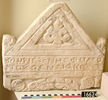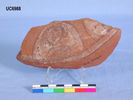| Homepage | Timeline | Maps | A-Z index | Learning |
Art in Egypt during the Byzantine Period: Coptic Art
Coptic art is quite often treated as isolated, but Egypt and its art are in the Byzantine and early Islamic Period part of the Byzantine and then Arab empires. Christian art in Egypt was always very much influenced by Byzantine art; only after the Arab conquest of Egypt (AD 641) did this influence become less important. Only for this period would the term 'Coptic art' seem to be accurate.
Typical features of Coptic art are also found in Byzantine and 'late antique' (late Imperial Roman) art in general. Human figures are very often depicted frontal. Eyes are drawn wide, as if expressionist rather than realist. Figures may appear rather out of proportion, in comparison with classical Greek and Roman art. There is a wide range of quality. Some works seem to have been produced by Imperial Byzantine workshops and can be hard to distinguish from contemporary works in Constantinople or other metropolitan centres of the Byzantine empire. Other works seem to have been produced by local workshops. Prominent categories in Coptic art are relief, painting, textiles and architecture. Free standing sculpture is not common. The motifs shown are often Christian, as might be expected, but pagan motifs also continued in use; Christian art in other lands also regularly adapted pagan classical motifs to the message of the new faith.
(click on the images for more information and a larger picture)
 |
 |
 |
 |
 |
 |
 |
Further reading:
There is an extensive bibliography on Coptic art including many exhibition catalogues. Only a brief selection is given here.
|